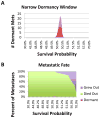The dormancy dilemma: quiescence versus balanced proliferation
- PMID: 23794703
- PMCID: PMC3702639
- DOI: 10.1158/0008-5472.CAN-13-0356
The dormancy dilemma: quiescence versus balanced proliferation
Abstract
Metastatic dissemination with subsequent clinical outgrowth leads to the greatest part of morbidity and mortality from most solid tumors. Even more daunting is that many of these metastatic deposits silently lie undetected, recurring years to decades after primary tumor extirpation by surgery or radiation (termed metastatic dormancy). As primary tumors are frequently curable, a critical focus now turns to preventing the lethal emergence from metastatic dormancy. Current carcinoma treatments include adjuvant therapy intended to kill the cryptic metastatic tumor cells. Because such standard therapies mainly kill cycling cells, this approach carries an implicit assumption that metastatic cells are in the mitogenic cycle. Thus, the pivotal question arises as to whether clinically occult micrometastases survive in a state of balanced proliferation and death, or whether these cells undergo at least long periods of quiescence marked by cell-cycle arrest. The treatment implications are thus obvious--if the carcinoma cells are cycling then therapies should target cycling cells, whereas if cells are quiescent then therapies should either maintain dormancy or be toxic to dormant cells. Because this distinction is paramount to rational therapeutic development and administration, we investigated whether quiescence or balanced proliferation is the most likely etiology underlying metastatic dormancy. We recently published a computer simulation study that determined that balanced proliferation is not the likely driving force and that quiescence most likely participates in metastatic dormancy. As such, a greater emphasis on developing diagnostics and therapeutics for quiescent carcinomas is needed.
©2013 AACR.
Conflict of interest statement
Two of the authors (A.W. and L.G.G.) have intellectual property positions and patent(s) on the bioreactor that have been assigned to their respective Institutions (Univ Pittsburgh and MIT).
Figures


Similar articles
-
Modeling boundary conditions for balanced proliferation in metastatic latency.Clin Cancer Res. 2013 Mar 1;19(5):1063-70. doi: 10.1158/1078-0432.CCR-12-3180. Epub 2013 Jan 17. Clin Cancer Res. 2013. PMID: 23329811 Free PMC article.
-
An in vitro system to study tumor dormancy and the switch to metastatic growth.J Vis Exp. 2011 Aug 11;(54):2914. doi: 10.3791/2914. J Vis Exp. 2011. PMID: 21860375 Free PMC article.
-
Regulation of Metastatic Tumor Dormancy and Emerging Opportunities for Therapeutic Intervention.Int J Mol Sci. 2022 Nov 11;23(22):13931. doi: 10.3390/ijms232213931. Int J Mol Sci. 2022. PMID: 36430404 Free PMC article. Review.
-
Primary and metastatic tumor dormancy as a result of population heterogeneity.Biol Direct. 2016 Aug 23;11(1):37. doi: 10.1186/s13062-016-0139-0. Biol Direct. 2016. PMID: 27549396 Free PMC article.
-
Micrometastatic disease and metastatic outgrowth: clinical issues and experimental approaches.Future Oncol. 2009 Sep;5(7):1083-98. doi: 10.2217/fon.09.73. Future Oncol. 2009. PMID: 19792975 Review.
Cited by
-
Concomitant attenuation of HMG-CoA reductase expression potentiates the cancer cell growth-inhibitory effect of statins and expands their efficacy in tumor cells with epithelial characteristics.Oncotarget. 2018 Jun 29;9(50):29304-29315. doi: 10.18632/oncotarget.25448. eCollection 2018 Jun 29. Oncotarget. 2018. PMID: 30034619 Free PMC article.
-
SOX1 acts as a tumor hypnotist rendering nasopharyngeal carcinoma cells refractory to chemotherapy.Cell Death Discov. 2023 Jun 27;9(1):194. doi: 10.1038/s41420-023-01479-x. Cell Death Discov. 2023. PMID: 37369660 Free PMC article.
-
Mesenchymal Stem Cell-Secreted Exosomes and Soluble Signals Regulate Breast Cancer Metastatic Dormancy: Current Progress and Future Outlook.Int J Mol Sci. 2024 Jun 28;25(13):7133. doi: 10.3390/ijms25137133. Int J Mol Sci. 2024. PMID: 39000239 Free PMC article. Review.
-
Hydrogel technologies in andrology: advances in research and prospective applications.Front Pharmacol. 2025 Jul 28;16:1635007. doi: 10.3389/fphar.2025.1635007. eCollection 2025. Front Pharmacol. 2025. PMID: 40792211 Free PMC article. Review.
-
Attractor landscape analysis of colorectal tumorigenesis and its reversion.BMC Syst Biol. 2016 Oct 20;10(1):96. doi: 10.1186/s12918-016-0341-9. BMC Syst Biol. 2016. PMID: 27765040 Free PMC article.
References
Publication types
MeSH terms
Grants and funding
LinkOut - more resources
Full Text Sources
Other Literature Sources
Research Materials

